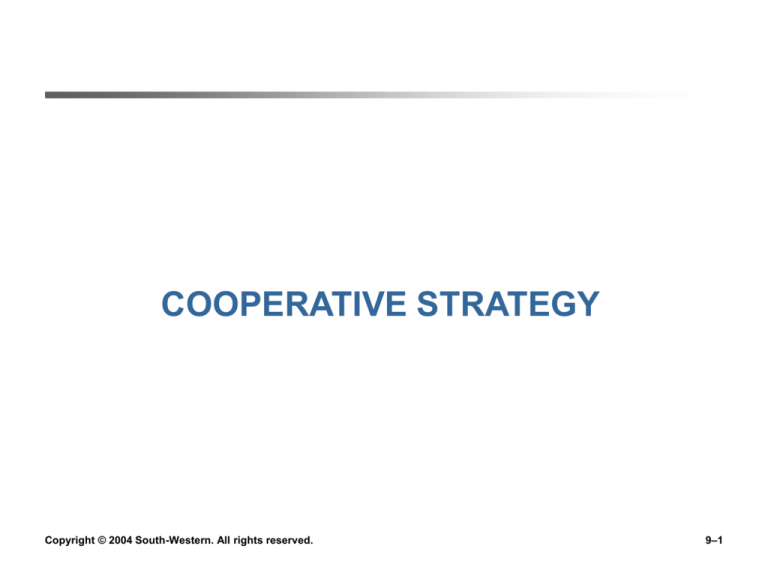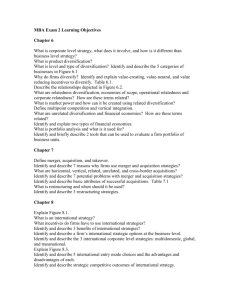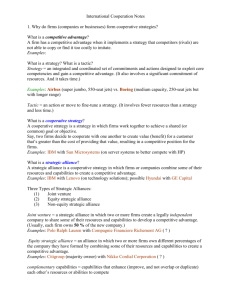
COOPERATIVE STRATEGY
Copyright © 2004 South-Western. All rights reserved.
9–1
Cooperative Strategy
• Cooperative Strategy
A strategy in which firms work together to
achieve a shared objective
• Cooperating with other firms is a strategy
that:
Creates value for a customer
Exceeds the cost of constructing customer value
in other ways
Establishes a favorable position relative to
competitors
Copyright © 2004 South-Western. All rights reserved.
9–2
Strategic Alliance
• A primary type of cooperative strategy in
which firms combine some of their
resources and capabilities to create a
mutual competitive advantage
Involves the exchange and sharing of resources
and capabilities to co-develop or distribute
goods and services
Requires cooperative behavior from all partners
Copyright © 2004 South-Western. All rights reserved.
9–3
Strategic Alliance Behaviors
• Examples of cooperative behavior known to
contribute to alliance success:
Actively solving problems
Being trustworthy
Consistently pursuing ways to combine partners’
resources and capabilities to create value
• Competitive advantage developed through a
cooperative strategy is called a collaborative
or relational advantage
Copyright © 2004 South-Western. All rights reserved.
9–4
Strategic Alliance
Firm A
Firm B
Resources
Capabilities
Core Competencies
Resources
Capabilities
Core Competencies
Combined
Resources
Capabilities
Core Competencies
Mutual interests in designing, manufacturing,
or distributing goods or services
Copyright © 2004 South-Western. All rights reserved.
9–5
Three Types of Strategic Alliances
• Joint Venture
Two or more firms create a legally independent
company by sharing some of their resources and
capabilities
• Equity Strategic Alliance
Partners who own different percentages of equity
in a separate company they have formed
• Nonequity Strategic Alliance
Two or more firms develop a contractual
relationship to share some of their unique
resources and capabilities
Copyright © 2004 South-Western. All rights reserved.
9–6
Reasons for Strategic Alliances
Market
Slow Cycle
Reason
• Gain access to a restricted market
• Establish a franchise in a new market
• Maintain market stability (e.g.,
establishing standards)
Copyright © 2004 South-Western. All rights reserved.
9–7
Reasons for Strategic Alliances (cont’d)
Market
Fast Cycle
Reason
• Speed up development of new goods
or service
• Speed up new market entry
• Maintain market leadership
• Form an industry technology
standard
• Share risky R&D expenses
• Overcome uncertainty
Copyright © 2004 South-Western. All rights reserved.
9–8
Reasons for Strategic Alliances (cont’d)
Market
Standard Cycle
Reason
• Gain market power (reduce industry
overcapacity)
• Gain access to complementary
resources
• Establish economies of scale
• Overcome trade barriers
• Meet competitive challenges from
other competitors
• Pool resources for very large capital
projects
• Learn new business techniques
Copyright © 2004 South-Western. All rights reserved.
9–9
Business-Level Cooperative Strategies
• Complementary strategic alliances
Vertical
Horizontal
• Competition response strategy
• Uncertainty reducing strategy
• Competition reducing strategy
Copyright © 2004 South-Western. All rights reserved.
9–10
Business-Level Cooperative Strategies
Complementary
Alliances
• Combine partner firms’
assets in complementary
ways to create new value
• Include distribution,
supplier or outsourcing
alliances where firms rely
on upstream or
downstream partners to
build competitive
advantage
Copyright © 2004 South-Western. All rights reserved.
9–11
Vertical Complementary Strategic Alliances
• Firms agree to use their skills and
capabilities in different stages of
the value chain to create value for
both firms
• Outsourcing
Adapted from Figure 9.2
Copyright © 2004 South-Western. All rights reserved.
9–12
Horizontal Complementary Strategic Alliances
• Partners combine resources and skills to create value in
the same stage of the value chain
• Focus is on long-term product development and
distribution opportunities
• Partners may become competitors
Adapted from Figure 9.2
Copyright © 2004 South-Western. All rights reserved.
9–13
Competition Response Strategy
Complementary
Alliances
Competition
Response Alliances
Copyright © 2004 South-Western. All rights reserved.
• Occur when firms join
forces to respond to a
strategic action of another
competitor
• Because they can be
difficult to reverse and
expensive to operate,
strategic alliances are
primarily formed to respond
to strategic rather than
tactical actions
9–14
Uncertainty Reducing Strategy
Complementary
Alliances
Competition
Response Alliances
Uncertainty
Reducing Alliances
Copyright © 2004 South-Western. All rights reserved.
• Are used to hedge against
risk and uncertainty
• These alliances are most
noticed in fast-cycle
markets
• An alliance may be formed
to reduce the uncertainty
associated with developing
new product or technology
standards
9–15
Competition Reducing Strategy
Complementary
Alliances
Competition
Response Alliances
Uncertainty
Reducing Alliances
Competition
Reducing Alliances
Copyright © 2004 South-Western. All rights reserved.
• Created to avoid destructive or
excessive competition
• Explicit collusion: when firms
directly negotiate production
output and pricing agreements in
order to reduce competition
(illegal)
• Tacit collusion: when firms in an
industry indirectly coordinate their
production and pricing decisions
by observing other firm’s actions
and responses
9–16
Assessment of Cooperative Strategies
• Complementary business-level strategic alliances,
especially the vertical ones, have the greatest
probability of creating a sustainable competitive
advantage
• Horizontal complementary alliances are sometimes
difficult to maintain because they are often between
rival competitors
• Competitive advantages gained from competition
and uncertainty reducing strategies tend to be
temporary
Copyright © 2004 South-Western. All rights reserved.
9–17
Corporate-Level Cooperative Strategies
Figure 9.3
Copyright © 2004 South-Western. All rights reserved.
9–18
Diversifying Strategic Alliances
Diversifying
Strategic Alliance
• Expand into new product or
market areas without
completing a merger or an
acquisition
• Synergistic benefits of a
merger or acquisition
less risk
greater flexibility
• Assess benefits of future
merger between the partners
Copyright © 2004 South-Western. All rights reserved.
9–19
Synergistic Strategic Alliances
Diversifying
Strategic Alliance
• Joint economies of scope
between two or more firms
Synergistic
Strategic Alliance
• Synergy across multiple
functions or multiple
businesses between
partner firms
Copyright © 2004 South-Western. All rights reserved.
9–20
Franchising
Diversifying
Strategic Alliance
Synergistic
Strategic Alliance
Franchising
• Spreads risks and uses
resources, capabilities, and
competencies without merger
or acquisition
• A contractual relationship (the
franchise) is developed
between the franchisee and
the franchisor
• Alternative to growth through
mergers and acquisitions
Copyright © 2004 South-Western. All rights reserved.
9–21
Assessment of Corporate-Level Cooperative
Strategies
• Compared to business-level strategies
Broader in scope
More complex
More costly
• Can lead to competitive advantage and
value when:
Successful alliance experiences are internalized
The firm uses such strategies to develop useful
knowledge about how to succeed in the future
Copyright © 2004 South-Western. All rights reserved.
9–22
International Cooperative Strategies
• Cross-border Strategic Alliance
A strategy in which firms with headquarters in
different nations combine their resources and
capabilities to create a competitive advantage
A firm may form cross-border strategic alliances
to leverage core competencies that are the
foundation of its domestic success to expand
into international markets
Copyright © 2004 South-Western. All rights reserved.
9–23
International Cooperative Strategies (cont’d)
• Synergistic Strategic Alliance
Allows risk sharing by reducing financial
investment
Host partner knows local market and customs
International alliances can be difficult to manage
due to differences in management styles,
cultures or regulatory constraints
Must gauge partner’s strategic intent such that
the partner does not gain access to important
technology and become a competitor
Copyright © 2004 South-Western. All rights reserved.
9–24
Network Cooperative Strategy
• A cooperative strategy wherein several firms
agree to form multiple partnerships to
achieve shared objectives
Stable alliance network
Dynamic alliance network
• Keys to a successful network cooperative
strategy
Effective social relationships
Interactions among partners
Copyright © 2004 South-Western. All rights reserved.
9–25
Network Cooperative Strategies (cont’d)
Stable Alliance
Network
• Long term relationships
mature industries where
demand is
relatively constant
predictable
• Stable networks exploit
economies (scale and/or
scope) available between
the firms
Copyright © 2004 South-Western. All rights reserved.
9–26
Network Cooperative Strategies (cont’d)
Stable Alliance
Network
Dynamic Alliance
Network
• Evolve in industries with
rapid technological change
leading to short product
life cycles
• Primarily used to stimulate
rapid, value-creating
product innovation and
subsequent successful
market entries
• Purpose is often
exploration of new ideas
Copyright © 2004 South-Western. All rights reserved.
9–27
Competitive Risks of Cooperative Strategies
• Partners may act opportunistically
• Partners may misrepresent competencies
brought to the partnership
• Partners fail to make committed resources
and capabilities available to other partners
• One partner may make investments that are
specific to the alliance while its partner does
not
Copyright © 2004 South-Western. All rights reserved.
9–28
Managing Risks in Cooperative Strategies
Figure 9.4
Copyright © 2004 South-Western. All rights reserved.
9–29
Managing Cooperative Strategies
• Cost minimization management approach
Formal contracts with partners
Specify
How
strategy is to be monitored
How
partner behavior is to be controlled
Goals that minimize costs and prevent
opportunistic behavior by partners
Copyright © 2004 South-Western. All rights reserved.
9–30
Managing Cooperative Strategies (cont’d)
• Opportunity maximization approach
Maximize partnership’s value-creation
opportunities
learn from each other
explore additional marketplace possibilities
less formal contracts, fewer constraints
Copyright © 2004 South-Western. All rights reserved.
9–31









